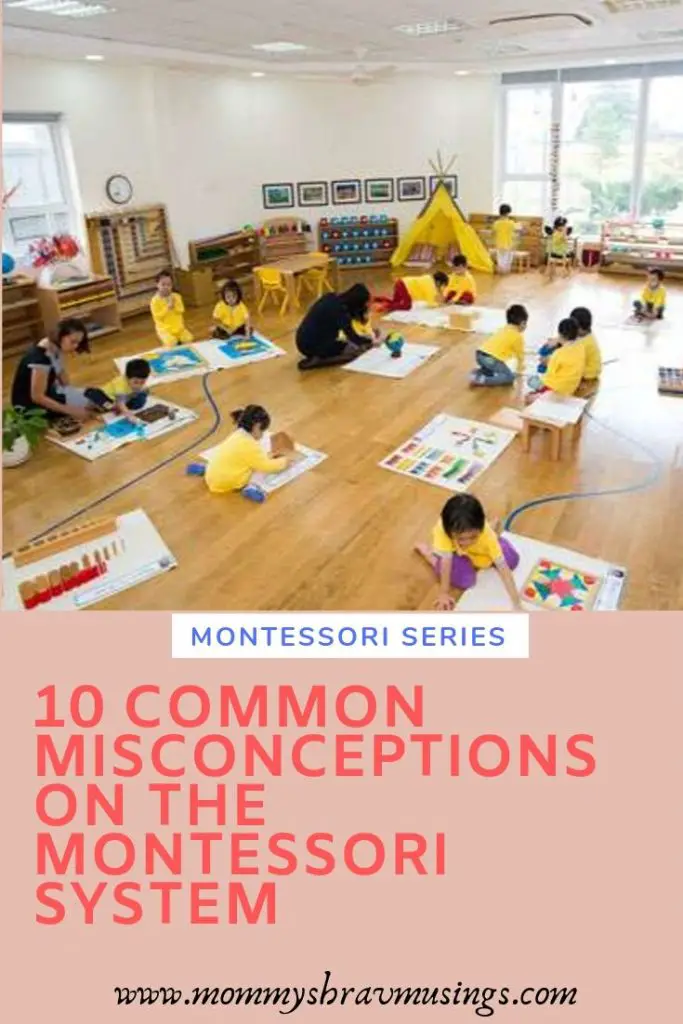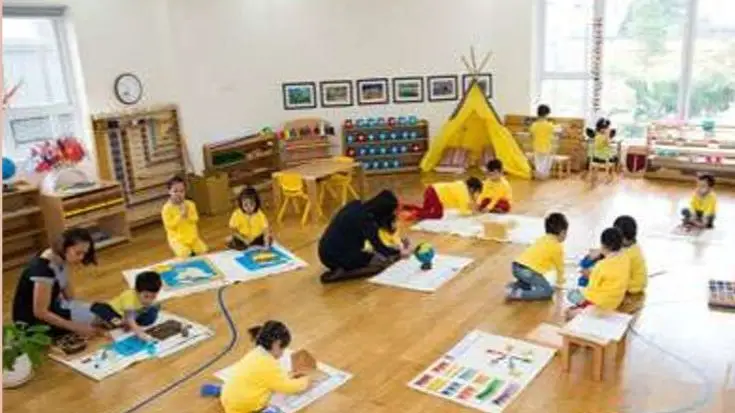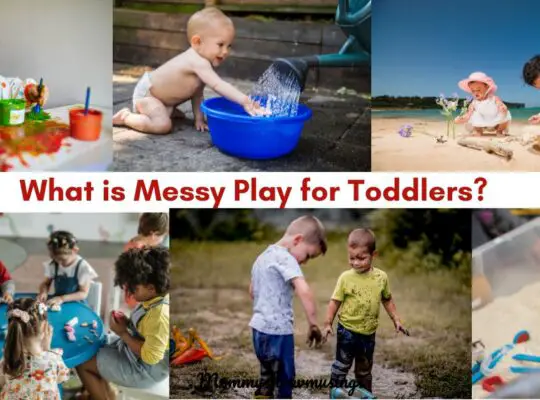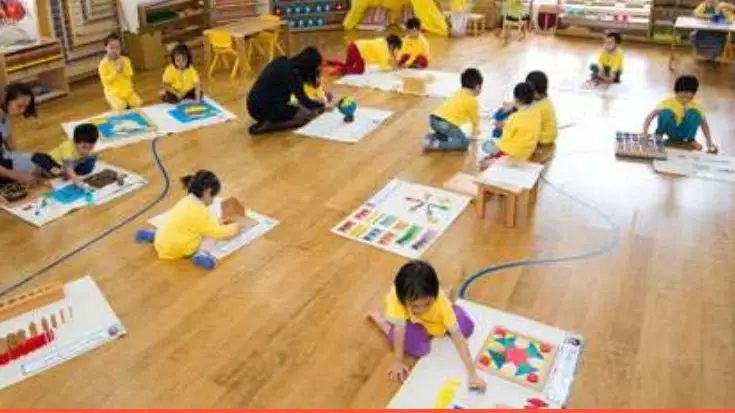There are a lot of questions and myths that Montessori parent encounters in their day-to-day life. And this post is trying to capture most of the most common misconceptions about the Montessori system that I have encountered to date in chronological order.
Misconceptions on the Montessori System:


- The Montessori curriculum is not at all academic.
- Research shows that Montessori children reach higher academic levels when compared to children studying in traditional schools. The reason behind this is the motivation of the Montessori children to learn their subjects of choice. And this motivation gives them higher academic excellence.
- Montessori teachers just don’t teach. As they don’t have any textbooks or notebooks and also no blackboard in the classroom
- Indeed, Montessori teachers don’t use the blackboard to teach. But their role as the knowledge perpetrator can’t be ignored. They give presentations to the individual child or to a small group of children and then step back so that the children can explore independently till the time they gain confidence on that particular topic.
- How come there is no homework for the Montessori children
- As per Montessori philosophy, the children have spent the entire morning learning various activities in school, and hence the evenings are meant to be spent with family members in a relaxing way. This allows them to explore the world around their house and also gives them ample time to mingle with others. The child will also be able to help the parents in the household activities, which are again informal learnings for him.
- Also, technically, the children would not have access to the Montessori tools at home to work on their homework that is another reason why Montessori schools discourage homework.
- Montessori classrooms don’t have any structure and are chaotic.
- For an outsider, the Montessori classroom looks chaotic, as kids sit everywhere and work. But this environment has been prepared very carefully based on the children’s developmental needs of the teachers. Children can move and explore but within the teacher’s limits. This environment reinforces the primary Montessori principle of freedom within limits.
- The Montessori method is only for self-learners (or gifted children) or children with special needs.
- Montessori methods are purely child-centric. So they are effective with all children and would suit both self-learners and children with learning disabilities. These methods never distinguish the children based on their learning abilities.
- Montessori children will not have any discipline.
- On the contrary, the Montessori children have more self-discipline when compared to the children who study in traditional schools, as these children are used to freedom within limits. So they automatically get tuned to act more disciplined. This discipline is inculcated in the kids without using sticks or punishments, as they understand the consequences and know what situations must be avoided.
- Older classmates bully the younger ones, so Montessori kids become very timid and shy.
- Yes, the Montessori environment always consists of a mixed-age group of children. Older children are often treated as role models by younger children. All children benefit from peer-to-peer teaching and working in groups. Because there is no competition, children feel comfortable sharing their knowledge and experience with other kids.
- Playful kids will never sit down and learn in the Montessori system.
- Montessori-prepared environment consists of only the work activity items, not the playthings. When all the children are busy working on one or another activity, even the most playful kid would sit down to work on an activity of his own interest. Once he understands the joy of handling the work items independently, he will sit down to learn/work automatically, without any pressure. That is why Montessori schools are stress-free for the children.
- Montessori children can’t compete in the outside world.
- As there are no exams or trophies to be won in the Montessori world, most adults think that Montessori children don’t have an idea about competition. But Dr. Maria Montessori termed these motivators like trophies, grades, and class rankings as external motivators, which wouldn’t sustain in the long run for continuous achievement. She proposed an intrinsic environment where the children learn to achieve higher potential only through their internal needs and motivation. So the Montessori children understand that the value of competition is more for engagement and fulfilling their need to achieve higher potential and not for just winning trophies or medals.
- Montessori children are not allowed to play.
- Children below 6 years of age can’t distinguish between work and play. All they do in the Montessori classroom is play for them. They enjoy being among their peers and interacting with them. The Montessori curriculum and the gross motor skill-developing activities include creative play like music, art, storytelling, and drama.
Another one of the misconceptions about the Montessori system that I found is that this system is mainly for rich people. But honestly, the school fees across various Montessori schools are more or less equal to that of the traditional schools.
“….education is not what the teacher gives: education is a natural process spontaneously carried out by the human individual. It is acquired by not listening to words, but by experiences upon the environment”
– Dr. Maria Montessori
As we have seen, most misconceptions about the Montessori system are born mainly out of ignorance, as this system is still not very popular in India. If we do little research, one would understand that this system would really introduce the joy of learning to children. Hope you all agree with this statement. Please let me know your views on this Montessori series in the comments.
Author’s Note:
Dear Reader, this is the seventh part of the eight-part Montessori Method and its philosophy Series, and please stay tuned for further updates on the same topic. The next part will address the most important books one can read to understand the Montessori philosophy.

Suhasini, IP, is the Author of the book “Practical Tips for Kids Mental Health.” As a certified kids and parents life coach, she helps/guides you toward a happy family life for your kids. She firmly believes that “Emotionally Happy Kids of today are the Mentally Strong and Happy Citizens of tomorrow.” Let’s make the world a happy and beautiful place for our kids to thrive.






Your post is an eye-opener for those who have these misconceptions.
I like this series on Montessori Education by you. I believe this system of education should be encouraged more and more in the country especially at the primary stage.But as you pointed out, there are many misconceptions regarding this system. Many people have the misconception that Montessori Education is only good till kindergarten stage. #readbypreetispanorama
Thanks a lot Preeti for your kind words. It means a lot to me
You have shared valid points. Will share your post as well.
Thank you Indumathi for your kind feedback
Honestly I had not heard of these misconceptions around the Montessori system. In fact, in Delhi, it is the most popular system of early child education.
Yes, In Delhi, the Montessori system is the most popular system, but whereas in South its still at its initial stages. Its gaining popularity only from this year. Thanks for stopping by